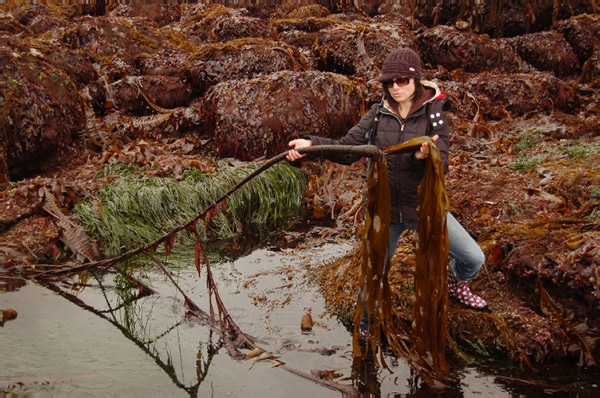|Home|Class Website|Seaweed Photos|
Halosaccion|Ulva|Contact Info|Literature Cited
Nereocystis leutkeana (Bull Kelp)
Phylum Phaeophyta, Class Phaeophyceae
 *Photo courtesy of Bonnie Becker.
*Photo courtesy of Bonnie Becker.
*Nereocystis leutkeana is a species of brown seaweed with common names bull whip kelp, or just simply bull kelp. Nereocystis leutkeana is found along open coastlines of the Pacific from Alaska to California. It grows in the subtidal zone in up to 20
meters of water and is one of the largest brown seaweeds, growing up to lengths of 40 meters long. This seaweed consists of a large branching hold, a long tubular stipe, a single bulb-shaped float, and numerous long,
smooth blades. The stipe grows up to 36 meters long, ending at the water's surface where the float is attached. The float has a diameter of 10 to 15 centimeters, and is filled with up to 3 liters of gases, one of which is carbon monoxide. Nereocystis leutkeana grows in large kelp forests,
their blades creating surface canopies. These forests serve as shelter for both marine fishes and invertebrates, and are an important food source for sea urchins.Nereocystis leutkeana grows for only one season,
and then dies off, the remains of which wash up on shore during storms.
The growing season of Nereocystis leutkeana is usually only from March to September. In the late summer and early fall you can often see dark brown coloured patches on the blades of bull kelp. These dark areas are spore patches, which hold groups of spores, and are called
sori. The patches fall out from the rest of the blade and settle onto the bottom. Once the spore patch reaches the substrate the spores are released and they grow into tiny, microscopic male and female gametophyte plants, which reproduce sexually.
The male gametophyte plant then releases sperm, which is attracted to the egg, which is retained by the female gametophyte. After the egg is fertilized the zygote grows into a new sporophyte.
This webpage is part of the UWT Marine Ecology 2007

